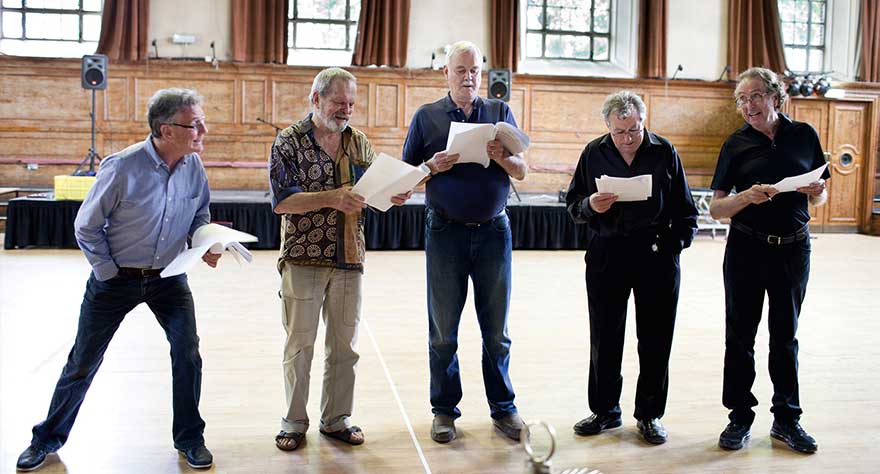
This whimsical doc about the legendary comedy troupe's historical reunion only caters to existing fans.

This whimsical doc about the legendary comedy troupe's historical reunion only caters to existing fans.
I’m not quite old enough to say I “grew up with” Monty Python, but I certainly became a fan of theirs in the 1980s, thanks mostly to reruns of Monty Python’s Flying Circus on PBS and the availability on their great films Monty Python and the Holy Grail (1975) and Life of Brian (1979) on VHS. Countless re-watches of those things and more led to memorization of scenes, bits, and lines, each countlessly recited by me and the guys at my lunch table, to the point that the legendary comedy troupe had become a considerable pop culture force in my life. I haven’t see the entirety of their collective work, but I’ve seen enough to call myself a loyal fan.
The primary narrative of the nonlinear documentary Monty Python: The Meaning of Live focuses on the historic live reunion show the troupe performed for 10 nights at the O2 Arena in London in July 2014. The show was titled Monty Python Live (Mostly): One Down, Five To Go. The “mostly” references the fact that some of the bits in the show are recorded and appear onscreen, at times in concert with the live portion. The subtitle is a little gallows humor referencing that five of the Pythons—John Cleese, Terry Gilliam, Eric Idle, Terry Jones, and Michael Palin—are still with us while the sixth, Graham Chapman, passed away in 1989.
Those five surviving members fully participated in the show, which was an old-time revue consisting of a blend of new comedic material, old and new musical numbers, and classic Python sketches (with the men reprising the roles they had made famous some 30+ years prior; where necessary, the Pythons filled in for Chapman’s characters). Behind the scenes, the doc reveals the surprising reason for the reunion and captures everything from the show’s inception to its production, including Idle’s early creative process (the troupe tapped him to write all the new material for the show), table reads, dress rehearsals, promotional media appearances, backstage scrambling, etc. Parts of the show itself are also shown, although no single sketch is shown in its entirety.
The O2 shows were historic because the last time the living Pythons performed together was at the Hollywood Bowl in 1980 (that concert film—Monty Python Live at the Hollywood Bowl—was released in 1982). The troupe had appeared together en masse in non-performing contexts since then, and they had performed in subsets since then, but only the O2 shows (originally conceived as a single performance, but eventually expanded to 10) featured full performances by the surviving five members.
This is the part of Monty Python: The Meaning of Live that is a big wet kiss to Python fans everywhere. It is glorious to see these septuagenarians perform the sketches and bits that made them famous, to do so at a comedic level that newcomers a third their ages would die to attain, and to show a spark in their eyes that belies the wrinkles around them. It’s also wonderful to watch the men interact, both onstage and off. This troupe is more than just an old comedy group; they are akin to a legendary rock band getting back together to reminisce about the past, play the greatest hits, and revel in the glory one more time.
That wet kiss, though, is pretty sloppy. The secondary narrative, the one more structured like a traditional documentary, is about an 80/20 blend of nostalgia and history, dating back to the troupe’s beginning days and running through the Hollywood Bowl performance. It’s a high-level history that covers moments in time like bullet points, albeit bullet points with hysterical pictures and video clips. It is a threadbare history of the troupe and its players, although not entirely without impact; the memories of Chapman still hurt, and they suit the presentation style particularly well.
Most striking about the Pythons’ present-day group dynamic is how positive they all are. It is clear these men recognize the history they are making and might never get the chance to make again, given their ages and individual schedules. It’s a bittersweetness that is never outwardly expressed, yet it is undeniably present. In fact, this “last great ride” vibe clearly affects the Pythons, or the filmmakers, or (I suspect) both in how their history is recalled and/or (selectively?) represented. The good old days weren’t always good, as the saying goes, but you wouldn’t know it from this doc. There isn’t a sense that anything onscreen is disingenuous, but it’s clear that the finality of today influences the perception of yesterday.
Monty Python: The Meaning of Live caters almost exclusively to existing fans. Because of the selective history presented and the rose-colored glasses through which that history is viewed, there isn’t enough to educate a Python neophyte. Also, because the sketch clips shown from various sources are incomplete, there is no way to give a newcomer a sense of what Python was all about. The film is still entertaining and someone new to Python won’t have a bad time, but at its best, the film is a whimsical companion piece to Python’s overall body of work.
Monty Python: The Meaning of Live made its Quebec Premiere on July 26th at Montreal’s Fantasia International Film Festival.